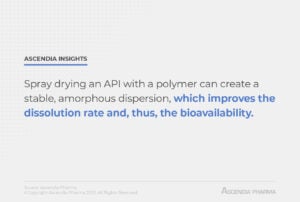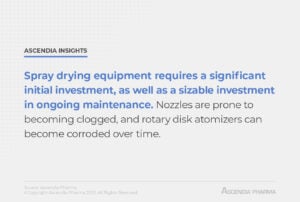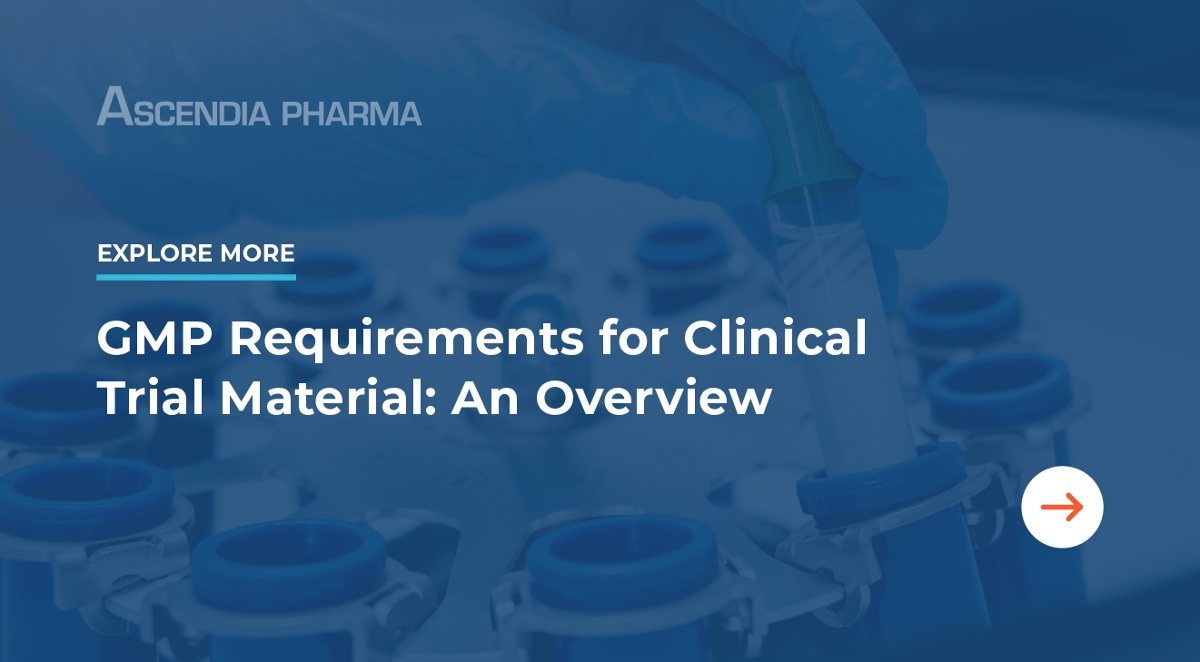Spray Drying: Advantages and Disadvantages
When it comes to formulation development, pharmaceutical spray drying is one of the most versatile solutions available today. This technology can be used successfully for poorly soluble small molecule active pharmaceutical ingredients (APIs), biologics, vaccines, and more. Below, we’ll discuss how spray drying works and the benefits and disadvantages of the spray drying process.
What Is Spray Drying?
While modern pharmaceutical spray drying relies upon advanced technology, it’s actually a method that dates back to the 19th century, and began being widely used for industrial purposes in the beginning of the 20th century. At that time, the most common use for spray drying was the production of milk powder.

Pharmaceutical spray drying began in the 1940s, with a variety of extracts, infusions, adrenaline, vitamin C, and inorganic medicinal salts. As the technology developed, the number of applications increased, particularly in the production of pharmaceutical excipients and isolation of temperature-sensitive and difficult to crystallize active ingredients.
Spray drying offers a gentle method of drying by exposing substances to only a short burst of extreme temperature, then providing a cooling effect via the evaporation process, which protects spray dried pharmaceuticals from higher bulk temperatures.
Spray Drying in the Pharmaceutical Industry
Over the last 25 years, there has been an increase in the number of poorly soluble new chemical entities (NCEs) and drug candidates. In fact, as many as 70 to 80 percent of compounds in the pharmaceutical pipeline today can be classified as poorly soluble. However, issues associated with poor solubility can lead to low bioavailability, resulting in suboptimal drug delivery.
Traditionally, formulating poorly water-soluble drugs has been approached by creating new salt forms or co-crystals. But, as drugs have become increasingly more insoluble, more sophisticated technologies and approaches have arisen.
One such approach is the formulation of a drug substance in amorphous form vs. the traditional crystalline form. This type of formulation, referred to as amorphous solid dispersion, improves drug bioavailability by increasing the rate and extent of its dissolution in biological fluid. Thus, this technique has become a standard for reaching bioavailability goals for poorly water-soluble drugs.
How does spray drying fit into the picture? Amorphous solid dispersions can be prepared by either hot melt extrusion or spray drying. This explains the rising popularity of spray drying in the pharmaceutical industry, as an increase in poorly soluble NCEs and drug candidates has triggered an increase in amorphous solid dispersions in need of spray drying.
In addition to being linked to a formulation approach for improving drug bioavailability, spray drying provides taste masking, especially for inhaled drugs (like powder insulin) and controlled-release formulations. Even the manufacturers of existing drugs are increasingly turning to spray drying as a means of reformulating to overcome lifecycle management challenges not addressed by their current formulations.
>> Related Read: How to Select a CDMO to Improve Drug Bioavailability and Solubility
How Does Spray Drying Work?
Spray drying atomizes a liquid feed into small droplets in a hot drying gas; this flash dries the droplets into solid particles. These particles are separated from the gas, then they are sent to the next phase of the pharmaceutical manufacturing process.
Here’s a more detailed look at each of the steps involved spray drying:

1. Feed Atomization
The first of the three stages of the spray drying process is atomizing the feed into a fine spray. The liquid feed used in spray drying can be a suspension, solution, or emulsion, and it’s atomized in a specialized drying chamber.
Atomization is typically accomplished using either a pressurized nozzle or rotary disk atomizer, although ultrasonic nozzles and two-fluid nozzles may be used when particles must be fine or for small scale manufacturing.
2. Drying Particles
Once the suspension, solution, or emulsion is atomized, the fine spray comes into contact with the hot drying gas. This causes the liquids to evaporate almost instantly, creating solid particles.
The solid particles that result from spray drying can be granules, a powder, or agglomerates.
When the feed and gas meet, the flow of the feed and gas can be counter-current, co-current, or mixed flow. Because it has a lower risk of damage from high temperatures and also because it’s more flexible, co-current drying is the most widely used type of spray drying. Countercurrent spray drying is typically only used for coarse substances that are thermally stable and require high temperatures for drying.
3. Separation
The final step in the spray drying process is to separate the dry particles from the gas. This is done by using a filter or a cyclone.
Even with three separate steps in the process, spray drying is quite fast because it involves feed atomization. An atomized feed generates a vast array of droplets from a liquid stream, creating a sizable surface area. The increased surface area allows the liquid to evaporate in as little as a few milliseconds, delivering a quick drying rate. The speed of the spray drying process means there’s little risk of thermal damage.
Pharmaceutical Spray Drying Advantages and Disadvantages
There are a number of reasons to choose spray drying for formulating pharmaceuticals, but the technique does have some disadvantages as well. A contract development and manufacturing organization (CDMO) that has experience using spray drying can help pharmaceutical companies make the right decision for their product.

Advantages of Spray Drying
Some of the most notable benefits of spray drying include:
• Improved Bioavailability
It’s common for many therapeutic compounds to be stable when they’re in crystalline form, but have poor aqueous solubility and poor dissolution rates. The result is a reduction in the bioavailability of the API, which can be so extreme as to completely erase any therapeutic benefits.
Spray drying an API with a polymer can create a stable, amorphous dispersion, which improves the dissolution rate and, thus, the bioavailability. It’s also possible to increase bioavailability by creating nanoparticles isolated in larger composite particles, then recovering them through spray drying.
>> Related Read: 4 Factors Affecting Solubility of Drugs
• Taste Masking
When a substance is encapsulated, its taste can be masked. Spray drying allows manufacturers to dissolve or suspend the API and biodegradable excipients, then atomize the feed and dry it into a powder.
While this may not seem like a noteworthy benefit of spray drying, the simple step of masking the taste of an API that’s bitter or unpleasant can greatly improve patient compliance. Taste masking with spray drying can be accomplished without compromising how a drug is released.
• Modified Release
Sustained or modified release can also be achieved through encapsulation. This can be beneficial for a number of different drug classes, reducing the dosage requirements for medications like antibiotics and psychiatric drugs. Eliminating peaks in drug concentration reduces side effects, as well.
• Aseptic Manufacturing
When a drug requires aseptic manufacturing, this presents a number of challenges, as current good manufacturing practice (cGMP) requirements for aseptic manufacturing are complex. Spray drying has many advantages over other forms of aseptic manufacturing, including lyophilization, which also dries the API.
Spray drying gives manufacturers a greater deal of control over both the process and the final form of the product. In many cases, spray drying is more cost effective than other aseptic techniques.
When spray drying is used for sterile manufacturing, the API is combined with excipients that have the same particle size distribution. When a sterile feed is atomized and spray dried, it creates sterile particles without the risk of introducing contaminants.
>> Related Read: cGMP vs. GMP: What’s the Difference?
 • Fine Powders
• Fine Powders
Spray drying allows manufacturers to create very fine powders, and as the number of inhaled drugs increases, this feature of spray drying is becoming more important. Many drugs that target pulmonary diseases must be inhaled into the lungs, but even large molecule biotherapeutics like hormones and peptides may be administered in this way. The challenge here is that particles must be small enough to be airborne until they reach the lungs; spray drying is up to this challenge.
• Improved Stability
Biologics have an ever-increasing market share, but these drugs are notorious for their instability. One of the methods that can make biologics more stable for shipping and storage is spray drying. Many types of vaccines, proteins, enzymes, monoclonal antibodies, and peptides can be stabilized using spray drying.
Disadvantages of Spray Drying
The downsides of the pharmaceutical spray drying process include:
• High Overhead
Spray drying equipment requires a significant initial investment, as well as a sizable investment in ongoing maintenance. Nozzles are prone to becoming clogged, and rotary disk atomizers can become corroded over time. For pharmaceutical companies, it makes sense to outsource spray drying to a skilled CDMO that already has the necessary equipment, and the knowledge and resources to maintain it.
• Not an Option for Every API
Spray drying only works for feeds that can be atomized. Often, dilutions and solvents can overcome atomization problems, but not always. Despite the brief exposure to high heat, there are also some substances that will melt once they come into contact with hot gas in the dryer.
• Not Widely Available
There aren’t very many manufacturing facilities with pharmaceutical spray drying capabilities, particularly when it comes to product and process development. Knowledge of spray drying, too, is limited in the pharmaceutical manufacturing industry. Ascendia has spray dryer equipment on site, and staff that are knowledgeable in using spray drying for all phases of the development lifecycle.
>> Related Read: Top CDMO Companies: Why Bigger Isn’t Always Better
Ascendia Pharma: Experts in Spray Drying Formulations
Most pharmaceutical companies are simply interested in finding the best way to formulate their API, whether that’s through spray drying or another technology. When you partner with Ascendia as your CDMO, you’ll have access to a wide range of formulation options, along with the support of our team of experts. We can study different formulation options concurrently to help get your drug to market faster, and we have the equipment to perform stability studies to determine the best option for your circumstances.
We have the ability to work with you through every stage of the drug development process, from formulation to manufacturing cGMP clinical trial materials, and beyond. Our team specializes in creating formulations for poorly soluble water molecules and other difficult to formulate drugs, and we can manufacture oral dosage forms, parenteral dosage forms, final dosage forms, and more.
Learn More About Spray Drying Advantages and Disadvantages
If you’d like to learn more about our spray drying capabilities at Ascendia, contact us today.



